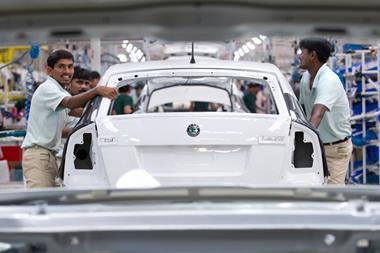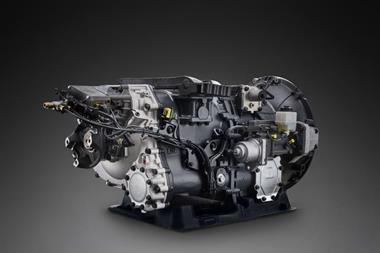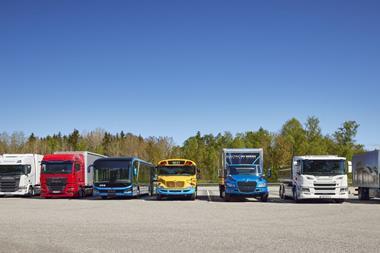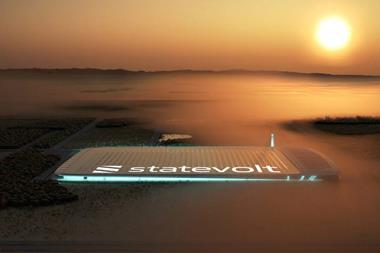
In an exclusive interview for AMS, Dr Andreas Tostmann, CEO of Volkswagen Slovakia, covers SUV and upcoming small car production at the plant. Plus a report on Audi Q3 production in Martorell, Spain
With almost one in four passenger vehicles sold in Europe made by the Volkswagen Group, it would seem fair to call the German carmaker a dominant force in the region. Its strategy of combining multiple modules into various platforms continues to pay huge dividends, not only for ease of manufacturing but also to the enormous benefit of profitability.
Vehicles from the Volkswagen, Audi, Škoda and SEAT brands may be made in any number of plants across Europe. Recently, a new Audi Q3 crossover entered production at SEAT’s Martorell facility in north-eastern Spain (see page 24), while three models from the ‘New Small Family’ series will soon be manufactured exclusively at the group’s facility in the Slovakian capital, Bratislava.
Before he took up his present role as Chief Executive of Volkswagen Slovakia, Andreas Tostmann oversaw operations at VW Group plants in Mexico and South Africa. Now, he is responsible for the launch of the as yet unnamed new small Volkswagen, Škoda and SEAT city cars, each of which will roll down the line at Bratislava later in 2011. Quite a contrast in manufacturing terms, considering that the plant is currently – and will remain – home to three large SUVs.
 In the interview with AMS, Tostmann was first asked to outline the production set up at the Bratislava plant. Andreas Tostmann: The plant is the main part of the manufacturing network of the VW Group here in Slovakia.
In the interview with AMS, Tostmann was first asked to outline the production set up at the Bratislava plant. Andreas Tostmann: The plant is the main part of the manufacturing network of the VW Group here in Slovakia.
What we are doing here is producing three different models: the Volkswagen Touareg, the Porsche Cayenne and the Audi Q7. But for the Cayenne, after it comes off the line, is it then sent to the Porsche plant in Leipzig, Germany, where they do the final assembly.
AMS: What about the hybrid versions of the Touareg and Cayenne? How does the production process differ from the petrol and diesel models?
AT: It starts with the pressed parts. We do have different parts for the hybrids; we do have separate bodies, too. That means in the bodyshop the process will be different. In the paintshop, the processes are the same and in assembly, we have huge differences. What I mean is that the cables, the control unit and so on, these are unique for the cars with the gasoline-electric powertrains. Also, the final assembly processes, these are not the same as for what I would call the ‘normal’ models.
Dr. Andreas Tostmann started his career at Volkswagen in 1990. His first production-related position was at the Puebla plant in Mexico, after which he returned to Germany to run the Volkswagen Group's production facility at Salzgitter (2001-2003), which builds petrol and diesel engines ranging in size from three to sixteen cylinders. After this, he took over as managing director at Volkswagen South Africa before being appointed managing director and chairman of the board of directors at Volkswagen Slovakia.
AMS: Given that the Touareg Hybrid and Cayenne S Hybrid were not launched at the same time as the standard models, how extensive was the retraining process for your existing production line workers?
AT: Yes, [training] was very extensive for our employees. We had to retrain about 1,000 of our employees over what was almost half a year in preparation for the Touareg hybrid alone.
AMS: Why did the training process take so long? AT: It’s a very new product, the first hybrid built by Volkswagen – the chance for Volkswagen Slovakia to show the quality of our workforce was very important, of course.
The technology is so advanced that so much extra training is necessary and our build quality must always be to the highest standard.
AMS: Are there other products planned for Bratislava?
AT: To give you an idea of what we have planned, there is a ‘New Small Family’ of cars, as we are calling them. We will add these to our product portfolio in the second half of this year. Within the New Small cars, there will be of course one for Volkswagen, but also there will be a model for SEAT and one for Škoda.
AMS: Will all three start production on the same line at the same time?
AT: We will produce them on the same line, but they will have staggered start-of-production dates.
AMS: The VW, which will be the production version of the former up! and space up! concepts, will it come first?
AT: I cannot say which model will be first to enter production.
AMS: Could you explain what specific activity has taken place to expand the Bratislava plant for production of these new cars?
AT: First of all, we have made an investment of €308 million to build the New Small Family models. We are talking also about 1,500 people who will work in this new area of our Bratislava plant. There has been a large investment in the paintshop and overall, quite a large extension made to our site to accommodate this additional production.
AMS: As the vehicles have nothing in common with the SUVs, you have a brand new line at the plant. AT: Yes, that’s right. We do have separate bodyshops and also the newly-added flexibility of the paintshop. Roughly €100m was invested for the paintshop. So now we have separate assembly lines running in parallel, one for the SUVs and one for the New Small Family products.
AMS: How old is the existing plant? AT: Volkswagen Slovakia is now 20 years old. Most of the buildings were constructed for the first generations of the Touareg and Cayenne, which were introduced in 2002. The Q7 was first produced in 2005. The second generation Touareg and Cayenne were launched in 2010.
AMS: Was the original plant in Bratislava a greenfield site?
AT: No, it was mostly a brownfield. But now half the plant is on the older part and the other half has been built on a greenfield site.
AMS: Would you say the plant is now one of the most modern in the VW Group’s global portfolio of build locations?
AT:Yes, and also that it is one of the most interesting for the products which we build. On the one hand, the different brands, and on the other, the different products as well as the hybrids and now the small cars as well.
AMS:Why do you think Bratislava was chosen for the New Small Family? Perhaps the low wages in Slovakia relative to Germany?
AT: Our employees were already highly skilled from building the SUVs, then it’s also a case of where we are located in central Europe. Of course, in Slovakia we have the euro, which is a strong argument in our favour as there are no exchange rate risks.
AMS: Is it fair to say these new small cars could not have been made at a profit in Germany or another high-wage European country?
AT: There are many advantages to building the cars in Slovakia. Yes, labour costs can be lower here but that is not the only factor.
AMS: Returning to the SUVs built in Bratislava, could you talk through at what state of assembly the Porsche Cayenne is shipped off to Leipzig?
AT: First of all, when we are talking about the Touareg, Cayenne and Q7, we are talking about the same production process for the different cars. We are producing the cars in the exact specification as they are ordered by customers. We use the Volkswagen Group philosophy to build these cars. What that means is that there is a certain system of processes – bodyshop, paintshop, and final assembly.
AMS: But what is not done at Bratislava which is then done by Porsche?
AT: They do the final assembly, as you have said.
AMS: Turning to the Audi Q7 and also bringing in the Cayenne, do the premium-brand cars have different aspects to their build, or higher-quality components? Perhaps more sound deadening or other related ‘luxury’ items?
AT: First of all, the cars themselves are very different models. The Q7 can be ordered as a five- or seven-seater; the Touareg is a five-seater but like the Q7 there is also a hybrid version, which shows you the complexity of the cars. As I mentioned earlier, we are producing the cars to customer order and so if you look at just the Touareg, we have more than one million possible combinations of specification. Therefore the parts can be very different on each model, but the standard of production, the standard of the components is always to the Volkswagen production process.
AMS: Are there are Tier suppliers which only cater to one of the three models?
AT:Yes, of course we have some suppliers who we take components from for one vehicle but also we receive components for all of these cars. Both are possible. For example, look at the engines. Most of these we get from Audi Hungaria; not far away from our Bratislava factory.
AMS: Will you also source the powertrains for the forthcoming small cars from Györ?
AT: No. The powertrain for our New Small Family come from a Volkswagen factory in Germany.
AMS: What is the build target, combined or individually, for those three new small cars for calendar 2012?
AT: Our projected volumes and our production schedule are not something we talk about outside the company. But I can tell you about 2010. Last year we built 145,000 cars in total.
 Volkswagen Bratislava was established in 1991, two years after the fall of communism in the former Czechoslovakia.
Volkswagen Bratislava was established in 1991, two years after the fall of communism in the former Czechoslovakia.
It was originally a joint venture between Bratislavské automobilové závody, a.s. and Volkswagen Aktiengesellschaft (AG), the first product of which was the VW Passat Variant or wagon. Later that year, assembly of the Golf was added, with gearbox build following in 1994. In the same year,
Volkswagen Slovakia became a wholly-owned subsidiary of the Volkswagen Group, changing its name to the present legal entity of Volkswagen Slovakia, a. s. in January 1999.
By 1998, the 100,000th vehicle had been made at Bratislava, the half-million unit mark was reached less than two years later. In late 2000, a component production plant for various Volkswagen, Audi and Škoda models was opened in Martin, located in Žilina, where Kia Motors Europe now has a major car and powertrain manufacturing plant.
Five years after Martin commenced operations, trial production of the then-new Audi Q7 was added at Bratislava, with mass production launched in November 2005. One year earlier, in 2004, a facility at Košice was established. Here, various vehicles from the Volkswagen, Audi, SEAT and Škoda brands are prepared for export to Russia and Ukraine.
The two millionth vehicle to be made at Bratislava, a VW Touareg, rolled down the line in 2007. For two years running, in 2007 and ’08, Volkswagen Slovakia received Slovakia’s National Productivity Award, with the firm also singled out by the country’s Ministry of the Environment for a special prize to recognise efforts made with regards to environmental protection.
Bratislava plant area: Total - 1,780,058m2, developed - 1,292,453m2
Martin plant area: 198,000m2
Employees (total, 2010): 9,964
Production (Bratislava): Volkswagen Touareg, Audi Q7, Porsche Cayenne
Production (Martin): components
Vehicle preparation: Košice plant
Output (total, 2010): 144,510 vehicles, 379,000 gearboxes, 31.5m further components
Vehicle and component production
As well as full production of the Volkswagen Touareg and the closely-related Audi Q7, Bratislava also makes bodies for the Porsche Cayenne, which uses the same architecture. While petrol V8 variants use Porsche engines, Cayenne Diesel and the Cayenne Hybrid use Volkswagen Group engines are gearboxes.
Martin, the component plant, produced some 31.5 million parts in 2010, including synchronizer rings, flanged shafts and casings for drums and differentials.
Volkswagen Group global production
In 2010, the number of vehicles delivered worldwide by the Volkswagen Group reached 7.203 million (2009: 6.336 million). This gave Volkswagen’s nine brands (Volkswagen, Audi, SEAT, Škoda, Volkswagen Commercial Vehicles, Bentley, Bugatti, Lamborghini and Scania) a combined 11.4% share of the world passenger car market.
In Western Europe, the Volkswagen Group controlled 22% of the total vehicle market in the first months of 2011. Last year, group sales amounted to €126.9bn (2009: €105.2bn), with net profit in the 2010 financial year totalling €7.2bn (2009: €0.9bn).
Each brand has its own character and operates as an independent entity in the market. The product range extends from low-consumption small cars to luxury vehicles. In the commercial vehicle sector, the product offering spans pickups, buses and heavy trucks.
From the first quarter of 2011 the group operates 62 production plants in fifteen European countries, with plants in a further seven countries across the Americas, Asia and Africa. Around the world, nearly 400,000 employees produce about 30,000 vehicles or are involved in vehicle-related services each working day. The Volkswagen Group sells its vehicles in 153 countries.
Audi Q3 starts volume production
The first Audi to be built at the SEAT factory in Martorell came off the line in June. The facility, located in Spain’s Catalonia region, is currently underutilized due largely to the collapse of the Spanish new vehicle market last year. The Volkswagen Group will be hoping that producing the Q3 at Martorell will re-invigorate the plant.
“The Q3 production is an example of how we are making use of synergies within the group,” claims Frank Dreves, Board Member for Production at Audi AG. “The Martorell factory is an extremely productive facility with a highlyskilled workforce, and one that meets the exacting quality standards of our brand. The Q3 definitely gets the Audi seal of approval.”
Approximately 100,000 units of the BMW X1 rival will be built per year, over three shifts. Audi and SEAT have invested a combined €330 million for improvements to the production facilities and associated infrastructure at the 18-year old SEAT factory. Already employing over 10,000 workers, 700 new hires have been taken on as part of the 1,500 staff now dedicated to Audi production. All staff have completed a 176-hour programme designed specifically for the Q3 to prepare them for the challenges they will face on the production line.
Much of the investment at Martorell has been for a new bodyshop, which was erected especially for Q3 production.
This features 450 robots, which have been installed at a 30,000m2 (323,000 sq. ft.) site. An innovative ‘roof bell’ system has been installed for the first time. Developed by the Audi Toolmaking Shop at the firm’s main plant at Ingolstadt, Germany, the system has a robot grab and precision align the roof in preparation for welding, just as a second robot prepares the next roof bell for the following body.
According to Audi, the base version of the Audi Q3 weighs less than 1,500kg (3,300 lbs). This, despite the use of ultra high-strength steels, which have been used extensively throughout the passenger cell. Aluminium, too, has played its part in reducing overall weight, the material used for various body panels. These include the bonnet and tailgate, that latter featuring a wraparound design with integrated light clusters, similar to that of the larger Audi Q7 SUV.
Asia-Auto: Ust-Kamenogorsk, Kazakhstan Škoda Superb
Audi Brussels: Forest, Belgium Audi A1
Audi Hungaria: Györ, Hungary Audi TT, Audi RS 3
Autoeuropa: Setúbal, Portugal SEAT Alhambra, VW Sharan, VW Eos
Bratislava, Slovakia Audi Q7 & Hybrid, VW Touareg & Hybrid, Porsche Cayenne bodies New Small Family: SEAT, Škoda and VW city cars
Crewe, UK Bentley Continental series and Mulsanne
Dresden, Germany VW Phaeton
Emden, Germany VW Passat, VW Passat CC
Eurocar: Solomonovo, Ukraine Škoda Fabia, Škoda Octavia, Škoda Yeti
Ingolstadt, Germany Audi A3 & S3, Audi A4, Audi A5, S5 & RS 5, Audi Q5
Kaluga, Russia Audi A4, Audi A5, Audi A6, Škoda Octavia, Škoda Roomster, Škoda Superb, VW Golf, VW Polo
Kvasiny, Czech Republic Škoda Roomster, Škoda Superb, Škoda Yeti
Martorell, Spain Audi Q3, SEAT Altea, SEAT Exeo, SEAT Ibiza, SEAT León, SEAT Toledo
Mladá Boleslav, Czech Republic Škoda Fabia, Škoda Octavia
Molsheim, France Bugatti EB 16.4 Veyron
Neckarsulm, Germany Audi A4, Audi A6, Audi A7, Audi A8, Audi R8
Pamplona, Spain VW Polo
Poznan, Poland Škoda Fabia, Škoda Octavia
Sant’Agata Bolognese, Italy Lamborghini Aventador, Lamborghini Gallardo
VW Osnabrück: Lower Saxony, Germany VW Golf Cabrio
Wolfsburg, Germany VW CrossGolf, VW Golf, VW Golf Plus, VW Tiguan, VW Touran, VW CrossTouran
Zwickau, Germany VW Golf, VW Passat
The Q3 is 4.39m long, 1.83m wide and 1.60m tall, making it shorter, wider and taller than its main rival, the BMW X1. It will be offered from launch with the choice of turbocharged 2.0-litre petrol and diesel engines. The Q3 will be first introduced in Germany, although not until the fourth quarter this year, indicative of how Audi and SEAT are taking extra care with a slow ramp-up that began in June.
Martorell will be the first but not the only plant to manufacture the Audi Q3. Following the model’s global premiere at the Shanghai Motor Show in April this year, it was stated that the Q3 would also be built in China, although no timeframe has been released. That said, the group’s forthcoming plant at Foshan, near Guangzhou, Guangdong province, will reportedly build SEAT and Audi models once it comes on line. With a capacity of 300,000 units per annum, it is likely that the plant will build the Q3 and the next Audi A3.
VW announced the project to build Foshan, the first production plant in the south of China for the FAW Volkswagen joint venture, in June 2010. The new site, where construction began in late 2010, will eventually employ 4,000 workers building a range of group vehicles. The plant will be a complete production facility, incorporating a press shop, bodyshop, paintshop and assembly units. The whole complex will extend over 170 hectares.




































